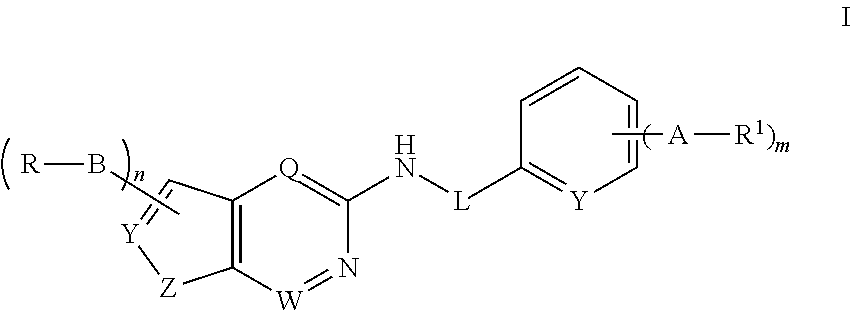N-containing heterocyclic compounds
- Summary
- Abstract
- Description
- Claims
- Application Information
AI Technical Summary
Benefits of technology
Problems solved by technology
Method used
Image
Examples
example 1
Synthesis of Compound 21
[0276]A mixture of 2-chloro-7-iodothieno[3,2-d]pyrimidine (500 mg, 1.69 mmol), 3-nitroaniline (280 mg, 2.03 mmol), p-TsOH.H2O (323 mg, 1.69 mmol) in 1,4-dioxane (10 mL) was heated in a microwave at 170° C. for 50 min, after which time a yellow precipitate formed. Water (20 mL) was added and the solid was collected by centrifugation and decanting off the liquid. The solid was washed with water (2×10 mL) then with ether (3×10 mL), and then dried by azeotroping twice with toluene. This provided compound 21 as a yellow solid (452 mg, 67%).
example 2
Synthesis of Compound 20
[0277]To a mixture of compound 21 (90 mg, 0.226 mmol), phenylboronic acid (33 mg, 0.27 mmol) and Pd[PPh3]4 (13 mg, 0.0112 mmol) was added toluene (1.65 mL), n-propanol (0.54 mL) followed by 2 M aqueous Na2CO3 (0.34 mL, 0.68 mmol). The resulting suspension was then heated at 90° C. for 2 h. Thin layer chromatography analysis suggested no reaction had occurred. N,N-Dimethylformamide (1 mL) was then added and the resulting homogenous solution was heated at 90° C. for a further 4 h. After cooling to room temperature, saturated aqueous NaHCO3 was added and the mixture was extracted three times with dichloromethane. The combined extracts were washed twice with water, brine then dried (Na2SO4). The solvent was removed under reduced pressure and the residue was purified by silica gel chromatography with 100% dichloromethane as eluent to afford compound 20 a bright yellow solid (35 mg, 45%).
example 3
Synthesis of Compound 1
[0278]A mixture of 2-chloro-7-iodothieno[3,2-d]pyrimidine (593 mg, 2.0 mmol), 4-morpholinoaniline (500 mg, 2.8 mmol) and N,N-diisopropylethylamine (0.87 mL, 5.0 mmol) in NMP (13 mL) was heated in a microwave at 240° C. for 25 minutes. Water was added and the mixture was extracted three times with ethyl acetate. The combined extracts were washed with 2% aqueous citric acid, water, brine and dried (Na2SO4). The solvent was removed under reduced pressure and the residue was purified by silica gel chromatography with 15-30% ethyl acetate / dichloromethane as eluent to provide compound 1 as a bright yellow solid (618 mg, 70%).
PUM
 Login to View More
Login to View More Abstract
Description
Claims
Application Information
 Login to View More
Login to View More - R&D
- Intellectual Property
- Life Sciences
- Materials
- Tech Scout
- Unparalleled Data Quality
- Higher Quality Content
- 60% Fewer Hallucinations
Browse by: Latest US Patents, China's latest patents, Technical Efficacy Thesaurus, Application Domain, Technology Topic, Popular Technical Reports.
© 2025 PatSnap. All rights reserved.Legal|Privacy policy|Modern Slavery Act Transparency Statement|Sitemap|About US| Contact US: help@patsnap.com



